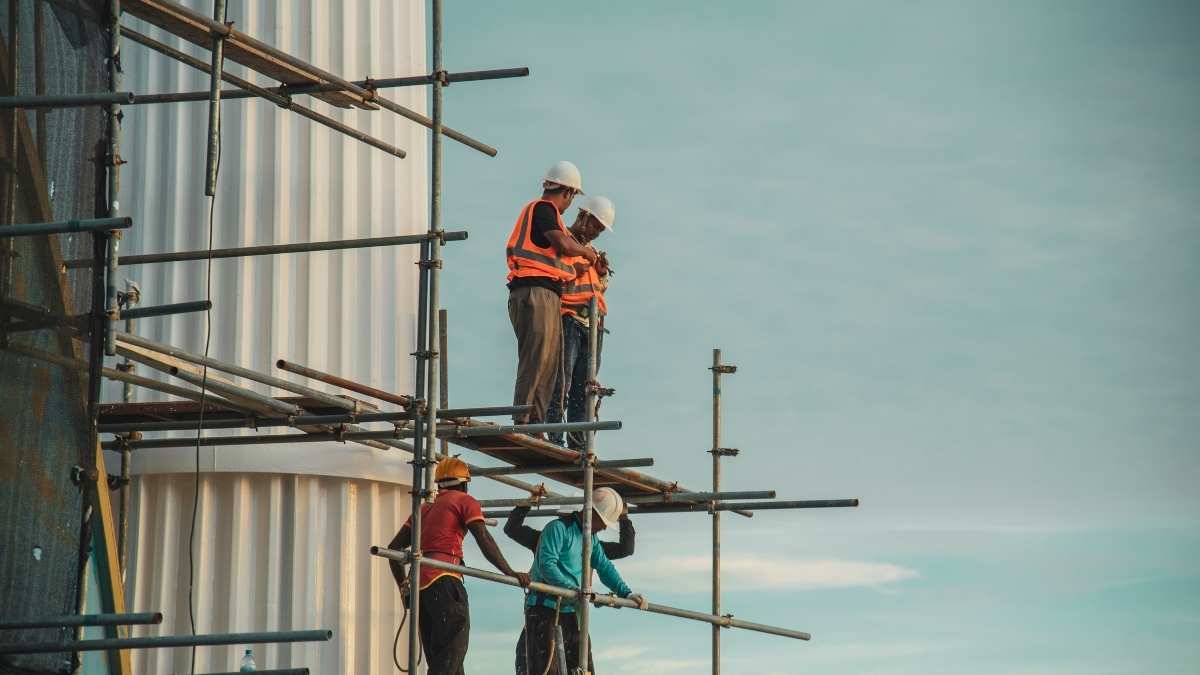Key Takeaways
- Scaffolding provides safety and efficiency for construction workers.
- There are various types of scaffolding available to meet different project needs.
- Proper use and maintenance of scaffolding can enhance project productivity.
Scaffolding improves safety and productivity in building projects by giving workers a solid and secure platform. It allows easy access to hard-to-reach areas, improves balance, and increases productivity. Scaffolding also supports heavy materials and tools, making it essential for maintaining safety and precision on construction sites.
Introduction to Scaffolding in Construction
Scaffolding is essential in the construction industry, offering workers a temporary and secure platform to perform tasks at elevated heights. It not only ensures the safety of the workforce but also boosts efficiency in carrying out construction activities. For those working in urban areas, options like ladder rental Bronx can be invaluable for projects requiring quick and reliable access to elevated work areas. Scaffolding reduces the dangers of heights by giving workers a stable and safe environment. This makes the job site safer and allows workers to concentrate more on their duties than their footing.
Types of Scaffolding
There are several types of scaffolding, each designed to suit different applications. Some standard scaffolding systems include:
- Supported Scaffolding: The most common type of scaffolding consists of one or more platforms held up by stiff, weight-bearing components like frames or poles. It’s versatile and can be used for both indoor and outdoor projects. This type of scaffolding is commonly seen in building construction, where it forms a matrix around the structure, offering a stable workspace at various heights.
- Suspended Scaffolding: Ideal for jobs requiring workers to reach elevated sections of a building, suspended scaffolding is hung from the roof or an upper level and can be raised or lowered to reach various heights. This method benefits window cleaning, building repairs, and external painting. It’s engineered to provide easy vertical movement, facilitating access to hard-to-reach places without additional structures.
- Rolling Scaffolding: This mobile scaffolding is supported by castors, making it easy to move around the site. It’s perfect for tasks that require frequent repositioning. For example, it can be used in large warehouses or on expansive construction sites where workers need to access different areas without dismantling and reassembling the scaffold.
- Trestle Scaffolding: Used primarily for indoor projects, trestle scaffolding comprises a working platform supported on movable tripods or ladders. It’s often utilized in scenarios requiring overhead work, such as electrical installations, ceiling repairs, or indoor painting. Its portability and ease of setup make it a popular choice for interior jobs.
Safety Benefits of Using Scaffolding
One of the primary advantages of scaffolding is the enhanced safety it provides. Properly erected scaffolding offers workers a stable and secure platform, reducing the risks of accidents and falls. According to a report by OSHA, a large percentage of injuries in the construction sector are caused by scaffolding mishaps. Adhering to safety standards and regular maintenance can mitigate these hazards. By implementing rigorous safety checks and ensuring proper training for workers, the risk of scaffolding-related injuries can be considerably lowered, making the work environment safer and boosting worker confidence and morale.
Efficiency and Productivity
In addition to safety, scaffolding significantly improves the efficiency and productivity of construction projects. With easy access to different building parts, workers can perform tasks more quickly and effectively. For instance, when scaffolding is employed, painting, plastering, and repairing damaged areas become less challenging and time-consuming. Workers no longer have to deal with inconvenient reaches or unstable surfaces, allowing them to focus entirely on the task. This improved accessibility can lead to quicker project completion and cost savings, as well-coordinated projects often result in less downtime and better resource management.
Choosing the Right Scaffolding
Selecting the appropriate scaffolding system for your project is crucial. Factors to consider include:
- The height and structure of the building
- The nature of the work
- The duration of the project
Consulting with scaffolding experts can help make an informed decision that ensures safety and efficiency. For example, suspended scaffolding might be the best option if the project involves multiple high-rise structures due to its flexibility and ease of use at various heights. On the other hand, for a long-term project involving detailed work on a single structure, supported scaffolding could provide the stability and support necessary for intricate tasks.
Maintenance and Inspection
Routine maintenance and inspections are essential to ensure that scaffolding remains safe and intact. Ensuring that the scaffolding components are in good condition and free of defects can prevent accidents and extend the life of the scaffolding system. The Health and Safety Executive (HSE) suggests doing routine inspections to find and fix any problems quickly. Routine inspections can spot issues like rust, wear and tear, or structural weaknesses before they become significant safety hazards. Preventative measures increase the scaffolding equipment’s useful life and lifespan while ensuring worker safety.
Conclusion
Incorporating scaffolding into construction projects offers numerous benefits, from safety to improved productivity. By choosing the right type of scaffolding and maintaining it properly, construction professionals can ensure a safer and more efficient working environment. In addition to giving workers a secure platform, scaffolding helps ensure that construction projects are completed on schedule and successfully. By prioritizing the correct use and upkeep of scaffolding, construction teams can achieve higher levels of safety and productivity, leading to successful project outcomes and enhanced worker satisfaction.
